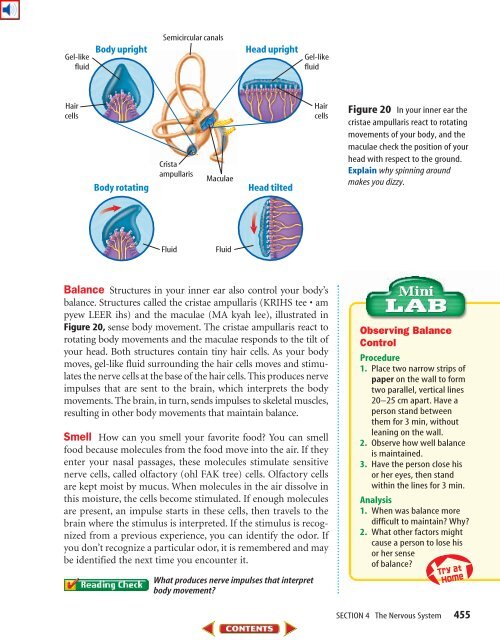Chapter 15: Support, Movement, and Responses - Science
Chapter 15: Support, Movement, and Responses - Science
Chapter 15: Support, Movement, and Responses - Science
Create successful ePaper yourself
Turn your PDF publications into a flip-book with our unique Google optimized e-Paper software.
Gel-like<br />
fluid<br />
Hair<br />
cells<br />
Body upright<br />
Body rotating<br />
Semicircular canals<br />
Crista<br />
ampullaris<br />
Maculae<br />
Fluid Fluid<br />
Head upright<br />
Head tilted<br />
Balance Structures in your inner ear also control your body’s<br />
balance. Structures called the cristae ampullaris (KRIHS tee • am<br />
pyew LEER ihs) <strong>and</strong> the maculae (MA kyah lee), illustrated in<br />
Figure 20, sense body movement. The cristae ampullaris react to<br />
rotating body movements <strong>and</strong> the maculae responds to the tilt of<br />
your head. Both structures contain tiny hair cells. As your body<br />
moves, gel-like fluid surrounding the hair cells moves <strong>and</strong> stimulates<br />
the nerve cells at the base of the hair cells. This produces nerve<br />
impulses that are sent to the brain, which interprets the body<br />
movements. The brain, in turn, sends impulses to skeletal muscles,<br />
resulting in other body movements that maintain balance.<br />
Smell How can you smell your favorite food? You can smell<br />
food because molecules from the food move into the air. If they<br />
enter your nasal passages, these molecules stimulate sensitive<br />
nerve cells, called olfactory (ohl FAK tree) cells. Olfactory cells<br />
are kept moist by mucus. When molecules in the air dissolve in<br />
this moisture, the cells become stimulated. If enough molecules<br />
are present, an impulse starts in these cells, then travels to the<br />
brain where the stimulus is interpreted. If the stimulus is recognized<br />
from a previous experience, you can identify the odor. If<br />
you don’t recognize a particular odor, it is remembered <strong>and</strong> may<br />
be identified the next time you encounter it.<br />
What produces nerve impulses that interpret<br />
body movement?<br />
Gel-like<br />
fluid<br />
Hair<br />
cells<br />
Figure 20 In your inner ear the<br />
cristae ampullaris react to rotating<br />
movements of your body, <strong>and</strong> the<br />
maculae check the position of your<br />
head with respect to the ground.<br />
Explain why spinning around<br />
makes you dizzy.<br />
Observing Balance<br />
Control<br />
Procedure<br />
1. Place two narrow strips of<br />
paper on the wall to form<br />
two parallel, vertical lines<br />
20–25 cm apart. Have a<br />
person st<strong>and</strong> between<br />
them for 3 min, without<br />
leaning on the wall.<br />
2. Observe how well balance<br />
is maintained.<br />
3. Have the person close his<br />
or her eyes, then st<strong>and</strong><br />
within the lines for 3 min.<br />
Analysis<br />
1. When was balance more<br />
difficult to maintain? Why?<br />
2. What other factors might<br />
cause a person to lose his<br />
or her sense<br />
of balance?<br />
SECTION 4 The Nervous System 455
















